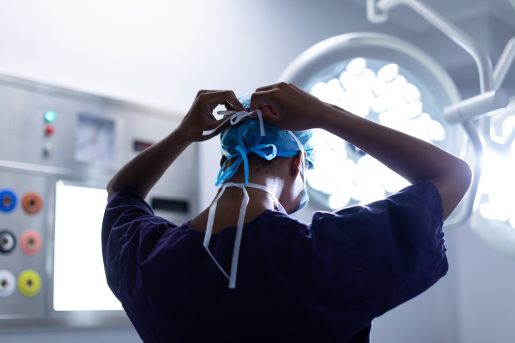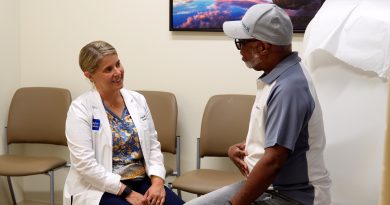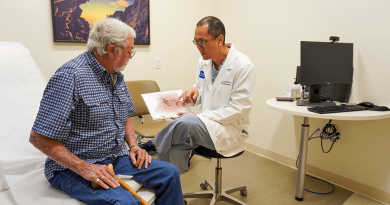How robotic-assisted Whipple surgery is changing pancreatic cancer care
 The Whipple procedure, or pancreaticoduodenectomy, has long been one of the most complex and challenging operations in surgical oncology. Used to treat cancers and other serious conditions of the pancreas, bile duct and duodenum, the surgery has undergone a remarkable evolution – from traditional open surgery to a highly precise, robotic-assisted approach that’s changing outcomes for patients.
The Whipple procedure, or pancreaticoduodenectomy, has long been one of the most complex and challenging operations in surgical oncology. Used to treat cancers and other serious conditions of the pancreas, bile duct and duodenum, the surgery has undergone a remarkable evolution – from traditional open surgery to a highly precise, robotic-assisted approach that’s changing outcomes for patients.
The Whipple procedure is most often used to treat pancreatic cancer, particularly tumors located in the head of the pancreas. It can also be used to address cancers of the bile duct or duodenum and certain benign conditions like chronic pancreatitis or cystic neoplasms.
Symptoms leading to diagnosis often are vague but can include jaundice, abdominal pain, unexplained weight loss, loss of appetite or back pain. Because symptoms are often subtle in early stages, pancreatic cancer is commonly diagnosed at a later stage, making early detection and timely intervention critical.
“Pancreatic cancer is one of the deadliest cancers,” said Dr. Omar Barakat, surgical oncologist at Baylor Medicine and professor of surgery at Baylor College of Medicine. “But surgery, particularly the Whipple procedure, remains the only potential cure.
That’s why advances in surgical technique are so important.”
Diagnosis
Diagnosis typically begins with imaging such as CT scans or MRIs, followed by biopsy and possibly endoscopic ultrasound. A multidisciplinary team of surgeons, medical oncologists, gastroenterologists and radiologists reviews each case to determine if the patient is a surgical candidate.
“We look for whether the tumor is resectable and whether the patient is healthy enough to withstand such a complex operation,” said Dr. George Van Buren II, surgical oncologist at Baylor Medicine and professor of surgery at Baylor College of Medicine. “Once we determine that surgery is possible, we tailor our approach to each case.”
The original Whipple
First performed in the 1930s by Dr. Allen Whipple, the original procedure involved removing the head of the pancreas, the duodenum, a portion of the bile duct, the gallbladder and sometimes part of the stomach. The remaining organs are then carefully reconnected to allow for digestion.
This open approach remains highly effective, but it involves a large incision and a long recovery period. It also carries a high risk of complications such as infection, delayed gastric emptying or leakage at surgical connection sites.
“We have made great advances to enhance the safety of the Whipple procedure,” said Dr. William Fisher, surgical oncologist at Baylor Medicine and director of the Elkins Pancreas Center. “With our modern early recovery pathways and extensive experience, we have reduced complications, shortened the hospital stay and overall recovery times.”
Robotic-assisted Whipple
One of the most transformative advancements in pancreatic surgery has been the adoption of robotic-assisted surgery. At Baylor Medicine, surgeons now routinely perform Whipple procedures using the robotic platform – giving them enhanced vision, precision and control in a minimally invasive environment.
“The robotic Whipple is an evolution, not a replacement,” Barakat said. “We’re taking everything we’ve learned over decades of open surgery and applying it with advanced technology that improves what we can do for patients.”
The benefits of robotic-assisted surgery are significant. Smaller incisions mean less pain, a lower risk of infection and faster recovery times. The robotic system provides 3D magnified views and wristed instruments that move with more dexterity than the human hand, allowing surgeons to work in tight spaces with enhanced precision.
“Patients who undergo robotic Whipple surgery are often surprised by how quickly they recover,” said Dr. E. Ramsay Camp, surgical oncologist at Baylor Medicine. “Many go home within a few days and return to normal activities faster than those who’ve had traditional open surgery.”
Early studies have shown that robotic Whipple procedures offer outcomes equal to or better than open surgery – with fewer complications and shorter hospital stays. At Baylor Medicine, the surgery is performed by a highly specialized team with extensive experience in both traditional open surgery and advanced robotic techniques.
“We are performing one of the most complex procedures in all of surgery through tiny incisions,” Van Buren said. “It’s a testament to how far we’ve come – and where we’re going.”
Ultimately, the choice of surgical approach depends on the patient, the tumor and the expertise of the surgical team. But for many, robotic-assisted Whipple surgery offers new hope in the face of a daunting diagnosis.
“Every patient deserves the most advanced care possible,” said Dr. Derek Erstad, surgical oncologist at Baylor Medicine and assistant professor of surgery at Baylor College of Medicine. “Our goal is to give each individual patient their best chance at long-term survival while minimizing the burden of surgery.”
By Tiffany Harston, senior communications associate in the Michael E. DeBakey Department of Surgery



